Remembering the Mike’s Place Suicide Bombing, Tel Aviv, April 30, 2003
So long ago, but reverberating to this day.
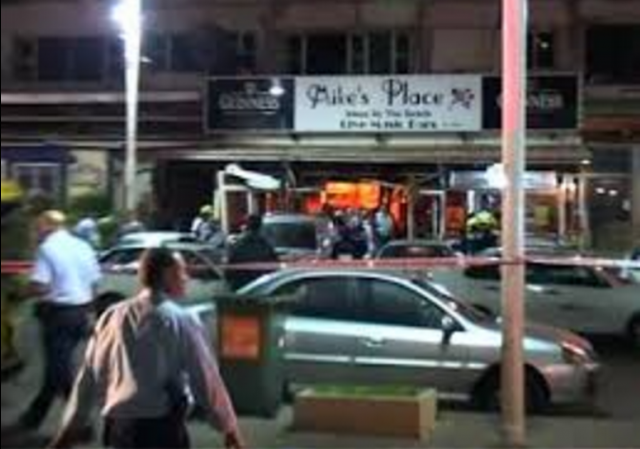
Earlier today I saw a tweet by Arsen Ostrovsky regarding the bombing of Mike’s Place in Tel Aviv in 2003:
I had heard of it, but only vaguely.
The list of Palestinian suicide bombings is so enormously long, I couldn’t remember the details. It was not one of the higher profile bombings, unlike the Dolphinarium disco (21 dead), the Sbarro Pizza restaurant (15 dead including 7 children), or the Park Hotel Passover Seder (30 dead).
As with other Palestinian terror attacks I have researched and written about, I learned that there were stories within stories, and surprises that made terror from decades ago so real today:
- Rasmea Odeh’s victims – then and now
- Remembering Haifa Bus 37 Suicide Bombing
- Israeli school bus bombing survivor reunites with nurse who saved him – 45 years later
So I set out to learn the story of the suicide bombing at Mike’s Place.
Mike’s Place, by the Beach
First, the basic history of Mike’s Place:
Mike, a retired photo-journalist started this tradition in 1993, when he opened a cozy little bar in downtown Jerusalem, where he welcomed all.
This tiny little pub that many people mistook for a private living room later became a prominent Jerusalem landmark.
From the very beginning, Mike’s Place attracted the most eclectic assortment of individuals: from travelers to native Israelis, foreign students to Russian immigrants. Arabs, Jews and Christians all sat together with, journalists, diplomats, soldiers and UN personnel – all sharing the good vibes, good music and great beer.
In the background, unique and unmistakable, the signature of Mike’s Place; free, live music – every night….
In July 2001, Mike’s Place opened in Tel Aviv. Next to the U.S. Embassy on the beach-front promenade, but the bar never abandoned its Jerusalem heritage even amongst the bright neon lights of Israel’s biggest city. The friendly, down-to-earth atmosphere still provides a welcome contrast to the trendy and often pretentious local nightlife.
The bar by the beach became a place where people could just relax and be themselves. True to its roots, the mix of live blues and rock-and-roll, with no cover charge, was a first for Tel Aviv.
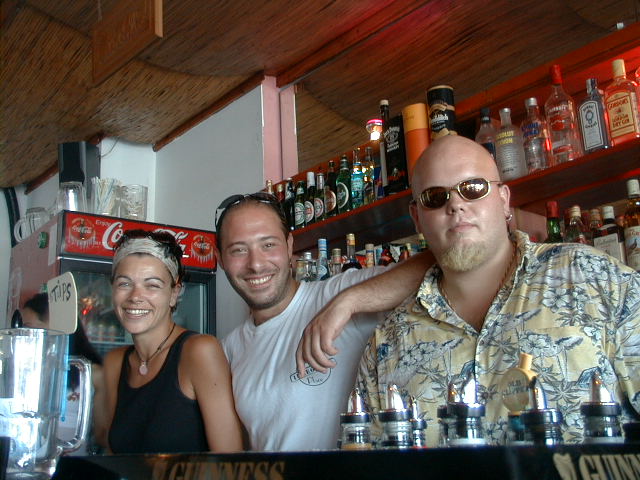
[Photo via Mike’s Place][Dominique Hass, left, was killed in the bombing]
The Suicide Bombing
And then it happened.
There were two bombers. One killed on the spot, the other later after his suicide belt didn’t go off. They were British Muslims. Not even Palestinian:
They were sent by Hamas, which claimed credit and released a video.Israeli authorities say the suicide bomber who killed three people in an explosion at a Tel Aviv cafe on Tuesday held British nationality.
They believe he was accompanied by a second British citizen, who also planned to carry out an attack, but who fled the scene.
More than 50 people were injured in the suicide bombing at a beachside bar called Mike’s Place.
Israeli television has shown passports alleged to belong to the two men, which name them as Asif Muhammad Hanif and Omar Khan Sharif.
The Israeli prime minister’s office released a statement on Wednesday evening saying Mr Hanif had been the suicide bomber, and that Mr Sharif had fled the scene after failing to detonate a second explosive device.
Palestinian militant group Hamas has released a video showing two Britons it says it used for a suicide bombing a year ago.
Londoner Asif Hanif, 21, killed three people and injured 55 by blowing himself up in Tel Aviv, last April.
Omar Khan Sharif, 27, of Derby, is thought to have fled after explosives strapped to his body failed.
The Israeli government said the Britons were part of a “terrorists’ war” being waged by Hamas on Israel.
Archived photos show the carnage. This video show’s the suicide bomber’s torso hanging from the rafters.
The Israeli Ministry of Foreign Affairs has detailed information on the attack, including the bombers’ travel and techniques. The second bomber was supposed to follow up the first explosion, presumably to kill first responders. This was the technique used by Rasmea Odeh in the SuperSol Supermarket bombing — the second bomb placed in a food package was timed to detonate shortly after the first bomb planted.
Telling the Story
The owner of that location at the time, Gal Ganzman, told his story to Esquire Magazine in 2007, What It Feels Like…to Survive a Suicide Bombing:
A bombing starts off smelling similar to a barbecue. There’s a charcoal-like whiff of gunpowder mixed with blood and burned flesh. It’s thick and bitter, and it overpowers everything. You can taste it in your mouth.
I opened Mike’s Place in Tel Aviv in 2000, three years before the bombing….
At around 1:00 a.m., I’m pouring a Carlsberg from the tap when I see a flash to my left just outside the bar and hear a high-pitched pop, like a firecracker. That’s it — no heat or wind or anything like that. I jump over the bar and put my hand on the 9mm strapped to my waist. I immediately understood that something was not right, but I didn’t know it was a bombing.
Outside, I saw that there was no struggle or fight. Everything is quiet. No noise. No screaming. Nothing yet. There are disoriented people walking slowly. A few people are getting up from the ground with bloody faces. Bodies are scattered about on the ground not moving. The row of cars I am used to seeing outside the bar looks different, black. It becomes clear that a bomb has gone off….
By the time I get back outside, a minute has elapsed since the bombing. The bitter smell of blood is strong now. A guy in the street is on fire. He’s trying to get up, but someone is patting at him to put out the flames. I turn, look back at the bar, and see the bomber for the first time. He’s missing his waist and his legs. His upper body is hugging the Mike’s Place sign above the door. The blood is dripping and black.
I stop a waitress named Saara and ask, “Have you seen Dom?” She is hysterical and says no. I get nervous, and for the first time, I look down to see who’s injured. She’s at my feet. She’s lost her left forearm. The stump, which ends at her elbow, is covered in dark blood. I yell her name: “Dom!”
Dominique was the first waitress I hired….I kneel down and wrap my arms around her. She’s breathing very heavily. “Hold on,” I say. “Everything will be okay.” She just looks at me with these brave eyes. I grab a handbag that’s lying near us and tie the straps tight around what remains of Dom’s left arm to stop the bleeding. The white tank top she is wearing is black from the blood and ash. My jeans and shirt are covered in blood. Her face, though, looks the same, totally beautiful. I press my lips to hers and give her a deep breath. To my left, I see the fat leg of the bomber. The bone is sticking out of the top side and white stuff is spilling out. I stay with Dom until the police and paramedics arrive. She’s still breathing, and they take her away….
Dom died on the way to the hospital, along with two others….
A filmmaker was present at the time, and later would write a book about the bombing and a documentary film, Blues by the Beach.
7/7/2005 Attack, Gaza Human Shields, and Arab Bank Trial
If that were all there were to the story, it would be bad enough and worth writing about.
But there are more recent connections, including to the July 7, 2005 British bus bombings (emphasis added):
The inquests into the 2005 London bombings, presented at the time as the conclusive and final judgement on the attacks, did not examine a potentially crucial part of the lead bomber’s back-story, a Sky News investigation has found.
The timing of an unexplained visit to Israel in early 2003 by lead 7/7 bomber Mohammed Sidique Khan was not addressed in any of the parliamentary or judicial investigations into the London attacks, despite the fact it occurred just weeks before two British men – with apparent connections to Khan – carried out a deadly suicide mission in Tel Aviv….
The attack on Mike’s Place bar on the beach in Tel Aviv in April 2003 was carried out by Britain’s first ever suicide bombers…..
After 7/7, numerous indications emerged that Khan might have been an associate of Sharif and Hanif.
All three were involved in the activities of the now-banned Al Muhajiroun group, led by radical preachers Omar Bakri Mohammad and Abu Hamza.
Sources have told Sky News Sharif travelled widely, and is believed to have visited the same mosque in Beeston as Khan at one period.
Most significantly, a 2006 BBC documentary featured an interview with Manchester businessman Kursheed Fiaz, who claimed the trio had approached him in 2001 seeking funding for a project to send young British Muslims for “education in the new ways of Islam” in Syria, Pakistan and Afghanistan.
Despite the fact Khan’s visit occurred shortly before the Tel Aviv attacks, and despite the post-7/7 indications that he may have had contact with the Mike’s Place bombers, the question of whether police properly investigated the Tel Aviv attackers’ backgrounds has not been asked – either in the post-7/7 parliamentary investigations or a wide-ranging inquest, both of which looked at the background and travel history of Khan.
Three also is a connection to the ongoing anti-Israel activism of the International Solidarity Movement, which is involved in the Gaza flotillas we have covered here. ISM members also served as human shields in Gaza during the 2014 war.
.@RobertMackey U know ur "human rights activist" organized human shields? https://t.co/9rZr1ap31g https://t.co/JYPfLXIRwC cc @CAMERAorg
— Legal Insurrection (@LegInsurrection) July 25, 2014
ISM, with whom Rachel Corrie was affiliated, is among the most aggressive international activists, particularly in Hebron. After the Mike’s Place bombing, ISM activists were expelled from Israel:
The Israeli authorities said yesterday [May 1, 2003]that they intended to step up deportations of foreign activists in the occupied territories. They said the alleged British suicide bomber, Asif Mohammed Hanif, and his accomplice, had posed as human shields to travel freely between Israel and the Gaza Strip.
Peace campaigners denied last night the two had posed as “human shields” for Palestinians. But the International Solidarity Movement (ISM) confirmed that Hanif and Sharif had attended a memorial service for a group member….
Just days before the attack, the two men were among people who paid their respects to Rachel Corrie, an American peace activist who was killed in March by an Israeli bulldozer. But Tom Wallace, an ISM spokesman, said they had not acted suspiciously during the ceremony and were “just part of the group”.
The Mike’s Place suicide bombing also featured prominently in the 2014 civil case against Arab Bank, which resulted in a precedent setting verdict holding financiers of terror responsible.
The NY Daily News reported on the 2014 trial, Witness identifies suicide bomber in 2003 attack on Tel Aviv bar:
So while the suicide bombing took place in 2003, the impact reverberates to this day.A documentary filmmaker who survived a suicide bombing in a Tel Aviv bar identified one of the alleged attackers for a Brooklyn jury deciding whether Arab Bank is liable for transferring millions of dollars to Hamas-controlled accounts.
“There was a lot of music going on and then the explosion,” said Josh Faudem, 38. “I jumped on my girlfriend and covered her. The bomber exploded right at the entrance of the bar.”
Federal Judge Brian Cogan ruled earlier that the witness could not provide gruesome details of the aftermath of the attack inside Mike’s Place that killed three people and wounded scores of patrons in April 2003.
The suicide bomber’s torso was found hanging from the rafters of the waterfront bar, which was located next to the U.S. Embassy.
Faudem, one of nearly 300 plaintiffs who were killed or wounded in terrorist attacks in Israel between 2000 and 2004, provided crucial testimony corroborating Hamas’ role in the murderous bombing.
Shown a photo that was posted a year later on a Hamas website of terrorists Asif Hanif and Omar Khan Sharif, who were credited with the Mike’s Place bombing, Faudem testified that he recognized Hanif.
“I saw (Hanif) about one-and-a-half hours before the bombing outside the bar,” Faudem recalled.
“People there still laugh, dance and listen to music”
On the Mike’s Place website there is this message of hope and resilience:
What is it like living in a state of perpetual war and terror? Israel is a paradise of sun and beach, of splendour and history. Is it crazy to live in a country where any day may bring death? Where 18-year-old boys and girls are required to enlist in the army? Where the mobile phone system collapses weekly under the pressure of worried Israelis checking-up on their loved ones? Israel is a place where daily life is both glory and affliction.
Mike’s Place is a popular live music bar on the Tel Aviv beachfront. It could be any rock and blues bar in any city, anywhere in the world. Three filmmakers chose Mike’s Place to show the bloodshed and fear on news broadcasts is not the whole story concerning Israel. People there still laugh, dance and listen to music despite the seemingly endless warfare and terrorism.
That’s a message I heard so often when I was in Israel last year, including from a Jew of Moroccan descent at Moshav Avivim along the Lebanese border, who lost his father and cousins in a school bus bazooka attack, in which he was severely injured:
What were his feelings over the years? Shimon felt that he had exacted revenge, but not in the way you might think.
Revenge, according to Shimon, came from the fact that “we are still here and building for another 70 families.”
That could be the end of the story, a story of triumph over evil at great cost, of perseverance, of building while others sought to tear down.
In memory of the three Israelis killed in the Mike’s Place bombing. There also was an American severely injured, Keith Trowbridge (37 at the time) about whom I have not been able to find out any information.
Say their names: Dominique Hass, Yanay Weiss, and Ran Baron.
A memorial has been created in their memory:
 DONATE
DONATE
Donations tax deductible
to the full extent allowed by law.


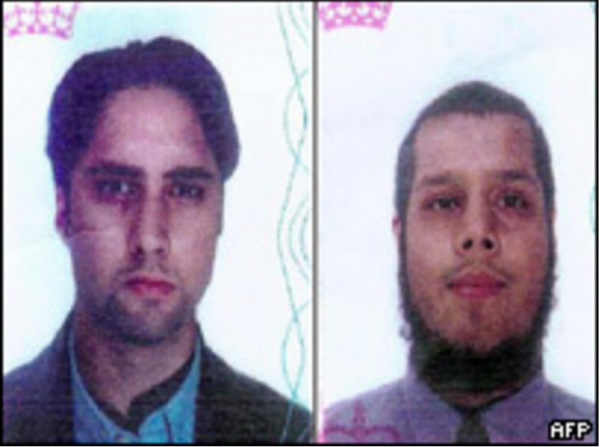
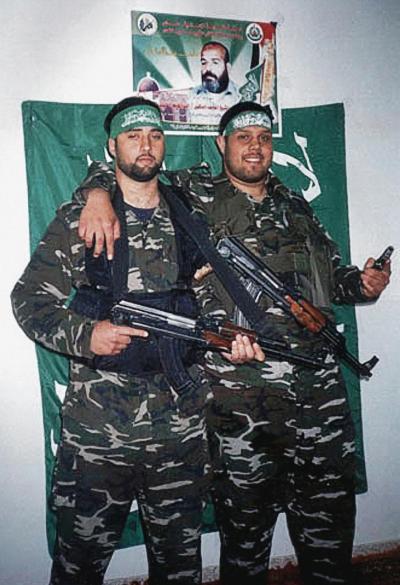
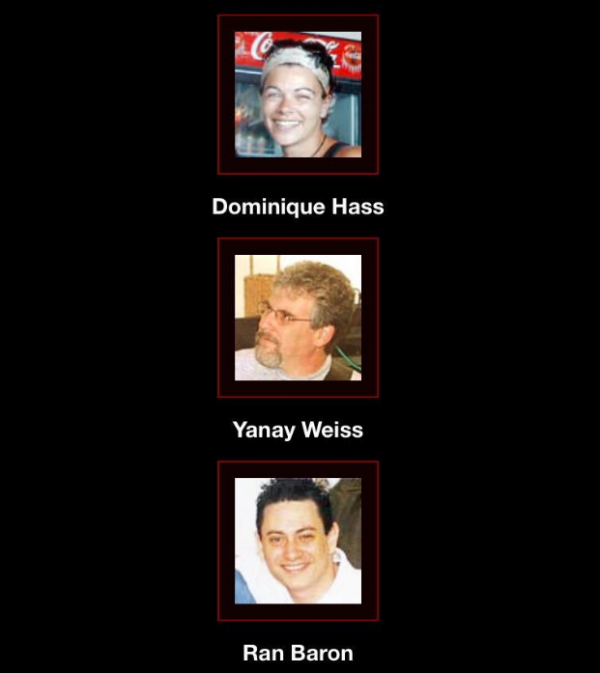
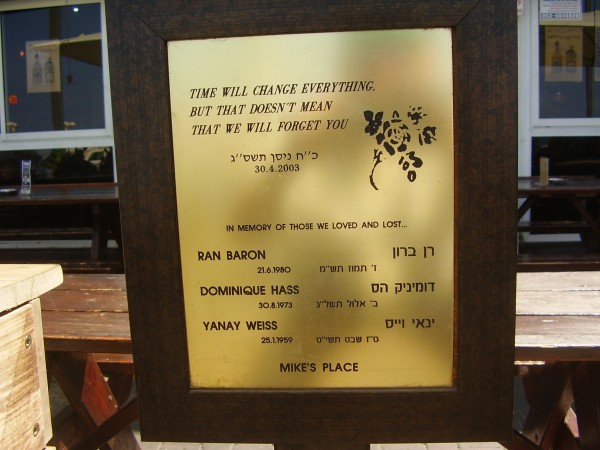








Comments
The targeting of innocent, unarmed civilians is and has been a war crime ever since such were recognized at all. It is the tactic of cowards and murderers, not warriors.